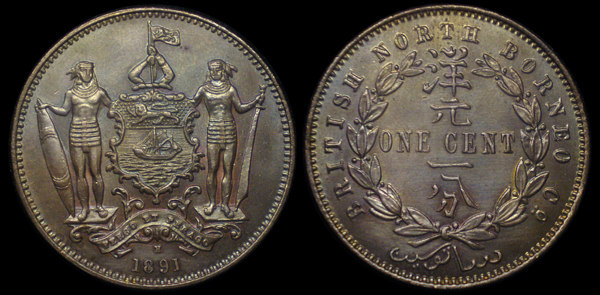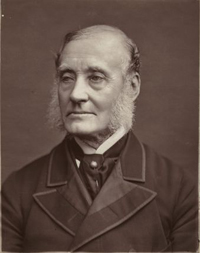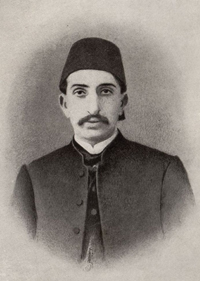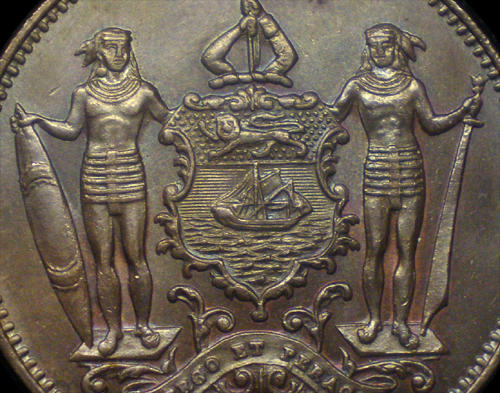
ONE CENT COIN - BRITISH NORTH BORNEO COMPANY - COAT OF ARMS
(KM 2)
Date: 1891
Obverse: Coat of arms of the British North Borneo Company and date - PERGO ET PERAGO / H / 1891
Reverse: Wreath, name and denomination - One Cent (English, Chinese and Malay below) / British North Borneo Co. around top
Ralph Heaton & Sons - Birmingham
Alfred Dent: A founder of the British North Borneo Company
Sir John Rutherford Alcock: Chairman of the British North Borneo Chartered Company from 1882-93
Hashim Jalilul Alam Aqamaddin: 25th Sultan of Brunei from 1885-1906 who entered into a treaty of protection with Britain in 1888 making Brunei a British Protectorate
Jamal ul-Azam: The 29th Sultan of Sulu who signed a concessionary treaty with Gustav von Overbeck in 1878 |
This is a bronze 1 cent coin of the British protectorate of North Borneo, a territory in the far north of the island of Borneo that was governed by the North Borneo Chartered Company (NBCC) also known as the British North Borneo Company (BNBC). Under its 1881 royal charter the British North Borneo Company gained the right to produce coinage. These coins were produced by Ralph Heaton and Sons Birmingham Mint and were possibly engraved by the very prolific medalist Joseph Moore. This coin was minted in 1891 under the tenure of Rutherford Alcock as Chairman of the Board of Directors. On the obverse is the Coat of Arms of the British North Borneo Chartered Company. In the middle is shield with a lion above a dhow (native boat) sailing on the water. The shield is supported by two native warriors, one holding a shield, the other a large native sword or machete. Above the shield are two arms clasping a flag staff, below the shield is a ribbon with the Latin motto PERGO ET PERAGO (I undertake and I achieve). Below the ribbon is the date 1891 and above the date is an H which is the mint mark for The Mint Birmingham Limited, known as Ralph Heaton and Sons Limited before 1879. On the reverse is a wreath of olive branches with the denomination ONE CENT in English in the center. Above and below the English denomination are Chinese characters which read "foreign dollar one cent". Below the wreath the denomination in Malay (Jawi script) reads "one cent" and around above reads BRITISH NORTH BORNEO Co. in English.
The territory of North Borneo was formed from the 1877-78 purchase of concessionary rights from the American merchant Joseph William Torry, who acquired them from the Sultanates of Brunei and Sulu, by the German businessman, adventurer and diplomat Gustav Overbeck (Baron von Overbeck) for $15,000. This transfer of concessions was dependent on Overbeck's successful renewal of rights from local leaders. Overbeck formed a joint venture company called the Dent & Overbeck Company with financing from the brothers Alfred and Edward Dent. In 1877 Overbeck received renewed concessions from the Sultan of Brunei and from the Sultan of Sulu in 1878. These concessions amounted to much of the territory of North Borneo. This drew the attention of Spanish forces stationed in the Philippines who contested the acquisition and forced Overbeck to seek aid to defend his newly acquired territory. Although he failed to attract much interest on the European continent, he did draw the interest of the British Empire. Overbeck transfered rights to the Dent brothers which led to the formation in 1881 of the British North Borneo Provisional Association Limited in 1881 to manage the territory and the establishment of the British Protectorate of North Borneo. The next year the company became the North Borneo Chartered Company. After the enactment of the Madrid protocol in which Spain relinquished rights in North Borneo but received recognition of their rightful presence in the Philippines (the Sulu Archipelago), North Borneo became a British Protectorate in 1888. The administration of North Borneo as a British Protectorate followed standard procedure made up of Residencies divided into Districts. Residencies were the seat of government for an area and were divided into Districts which were governed by district officers. British company men were top administrators while native chieftains governed at the local level. This was done as the British were unfamiliar with local customs and politics and believed such matters were best handled by local indigenous leaders. The top level British administration guided the development of the economy and industry as well as taking action to stem rampant piracy (one reason for the concessions) and arbitrating between leaders engaged in local feuds. It also outlawed slavery, developed infrastructure and transportation, educational services, a police force and allowed indigenous populations to continue in their traditional way of life. The British administration opened land to natives for farming but as the native population was not only small but often uninterested in in leaving behind their traditional lifestyle, the administration sought to attract workers from China. Tobacco was established as a major cash crop, logging operations were established and later North Borneo became a producer of rubber. Like its neighbor the Raj of Sarawak, North Borneo was occupied by the Japanese during World War II and after Allied liberation it became a crown colony. In 1963 North Borneo along with Sarawak joined the Federation of Malaya to become states within the new nation of Malaysia. |





